Most Competitive Soccer Leagues in Europe [Analysis]

We, at RunRepeat, looked at the results of 18,260 games from the last 10 seasons of the top 5 European soccer leagues – Premier League, La Liga, Serie A, Bundesliga and Ligue 1 - to bring you some answers.
Key Findings:
- La Liga and Premier League have been responsible for producing the most exciting title races in the last decade. 4 of the last 10 title races in both leagues have been decided on the final match-day.
- The average gap between the champions and the runners-up has been the lowest in La Liga at 6.5 points during the past decade.
- However, the Spanish league is also responsible for the biggest gap between the top and the bottom. On average, the bottom-five sides in La Liga manage to pick up only 7.4 points against the top-three every season.
- It is most difficult for teams to break into the top-4 in the Premier League. Only 7 different sides have managed to do so in the last ten years. At least 9 sides have managed to achieve the same feat in each of the remaining four leagues.
- As per our analysis, the Premier League has been the most competitive major European soccer league during the past decade.
Title-deciding round
Every soccer fan loves a title race that goes on till the last very last game of the season.
One important aspect of a competitive league is a title race which is undecided until the very last. This doesn’t happen often, but when it does, such seasons leave an imprint on the fans for decades.
And for this reason, Manchester City’s last minute title-triumph in 2011-12 is still regarded as one of the best season finales in recent history. Similarly, Arsenal fans still fondly remember their title-winning side from 1989.
Hence, as one of our criteria, we decided to compare the precise game-weeks during which the title race was decided in all five leagues during the past ten seasons.


- La Liga might have a reputation of being too predictable or lopsided, but when it comes to title races, the league has produced some nail-biting finishes during the past 10 seasons.
- For both the Premier League and La Liga, four out of the last ten title races have been decided on the final matchday.
- The 2015-16 Ligue 1 title race was the most one-sided one among the five leagues during the last decade as PSG won the title with eight rounds left in the season. The 2013-14 Bundesliga season was close behind as it was decided during the 27th-week of the 34-week season.
- Undoubtedly, both Bundesliga and Ligue 1 have produced some really one-sided title finishes during the last decade. Based on average scores, the German league figures lowest all five leagues despite having a 34-game season.
Competition at the top end
To further analyze how difficult it is for clubs to win the various leagues and how crowded it is at the top of various leagues, we compared the end-of-season points tally of sides finishing in the 1st, 2nd and the 5th position in each league during the past decade.
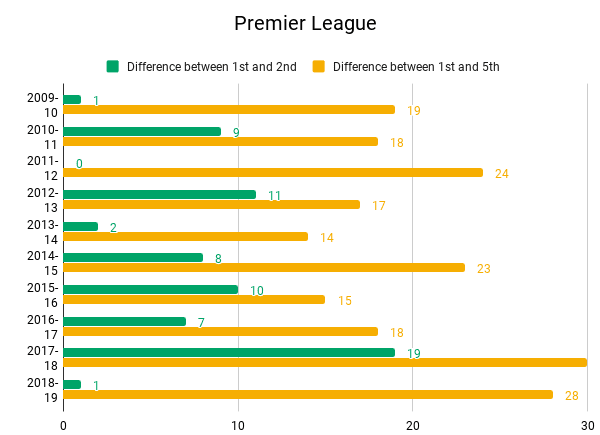
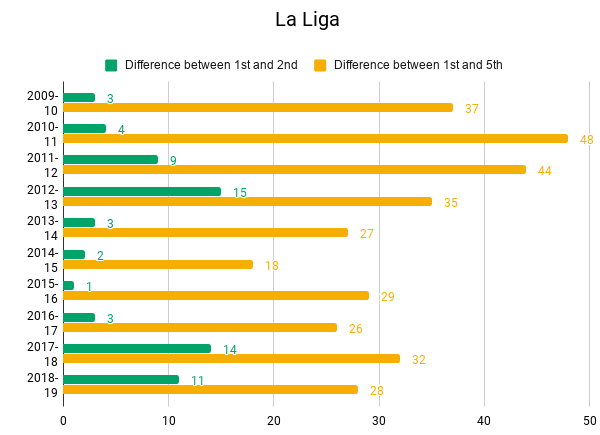
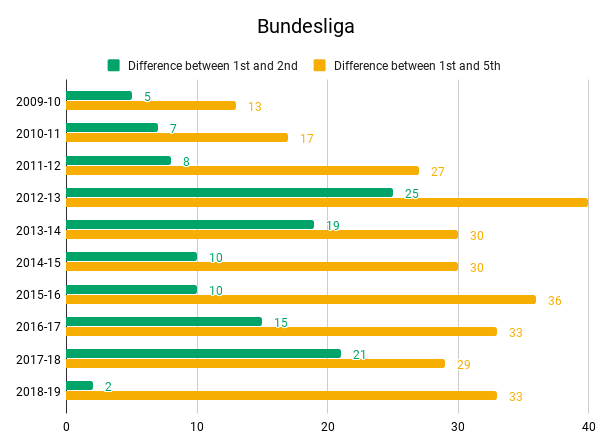
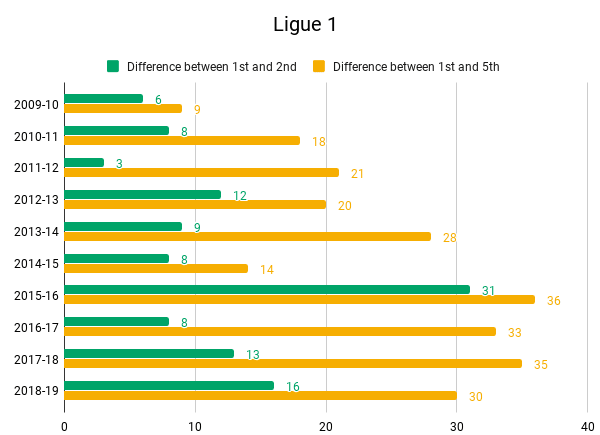
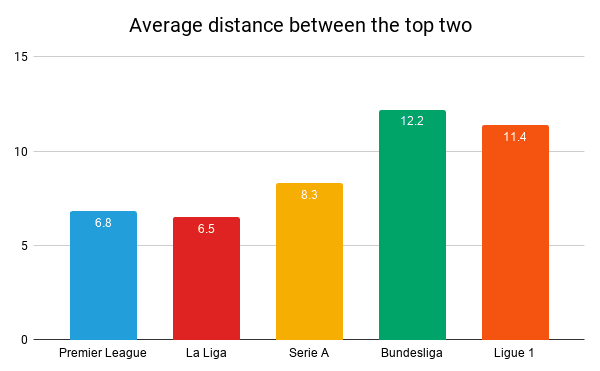

- Like our first analysis, La Liga and Premier League lead the way when we look at the level of competition between the eventual winner and the main challenger.
- However, La Liga slips down to the last spot when the average difference between the first and fifth are compared. This confirms the popular notion that the drop in quality in La Liga is huge when you move past the top two-three teams.
- Premier League maintains its position as the most competitive league in this comparison too.
- The difference between the top-two in Ligue 1 and Bundesliga is quite high. This is down to the fact that PSG and Bayern Munich have enjoyed rather comfortable multiple title triumphs in recent seasons.
- The 2011-12 Premier League season is the only instance of the top two sides finishing level on points during the past decade.
- There have been three seasons which ended with a single-point difference between the top two - Premier League 2009-10, 2018-19 and La Liga 2015-16.
- The 2009-10 Ligue 1 season was a real entertainer as the top five sides were separated by only nine points.
No. of different champions in the top five leagues
Our next criteria is to check the variety among winners and the teams finishing in European places in various leagues. This tells us about how many different sides have been able to challenge for the top places in various leagues.
Thus, in this section, we compare the number of teams that have won the different leagues and the number of teams that have finished in the top-four during the five-year and ten-year periods.

- In the last five years, three different sides have won Premier League and it performs well even in the ten-year comparison with four different winners.
- The likes of Serie A and Bundesliga have seen only one winner each in the last five years - Juventus and Bayern Munich respectively.
- Ligue 1 has seen five different winners in the last ten years, but only two in the last five. This suggests that the French League was really competitive just before the emergence of PSG.
No. of different sides to finish in the top-four
After comparing the variety among title winners, we shift our focus on the competition for the top-four places in different leagues.
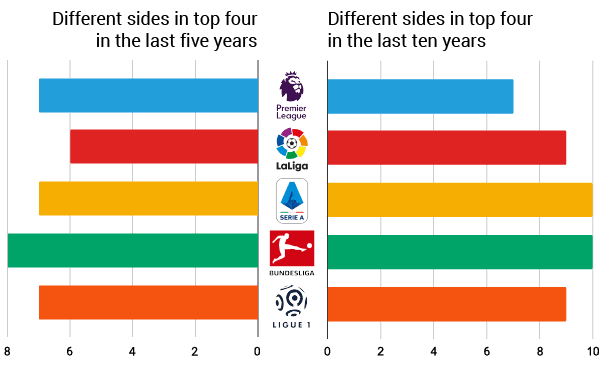
- There is hardly any difference between different leagues when you look at the data for the last five years.
- However, when you look at the ten-year comparison, the number of Premier League sides has stayed intact at seven, but the same figure has increased for all the remaining leagues.
- This points to the presence of the famous big-six in the Premier League during the past decade. Only Leicester City, in 2014-15, have managed to break this dominance.
- Hence, the Premier League might have been the most unpredictable league when it comes to title races during the last decade. But, it is most difficult for the non-favorites to break into the top-four in the top tier of English football.
- Serie A and the Bundesliga lead the way with ten different sides managing to finish in the top-four since 2009.
Defending champions vs promoted sides
One can argue that ahead of a new season, the defending champions are the strongest side in the league and the recently promoted sides are weakest ones.
Hence, to analyze the gap between the strongest and weakest sides in these leagues, we decided to look at the betting odds of all home games played by defending champions against the promoted sides.
We found out the average of odds associated with an away win in all these games to determine and compare how difficult it has been for the promoted sides to defeat the defending champions at their respective homes during the past decade.
NOTE: In this article, we have used the European version of betting odds. For those who are not familiar with odds, or the European odds, keep in mind that Probability = 1/Odds. Hence, the greater the odds are, the less likely is the outcome.
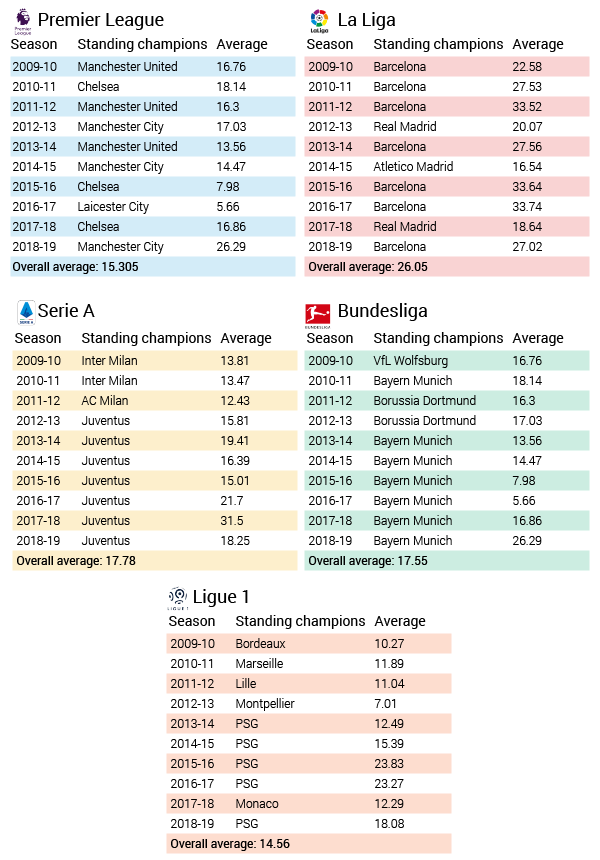
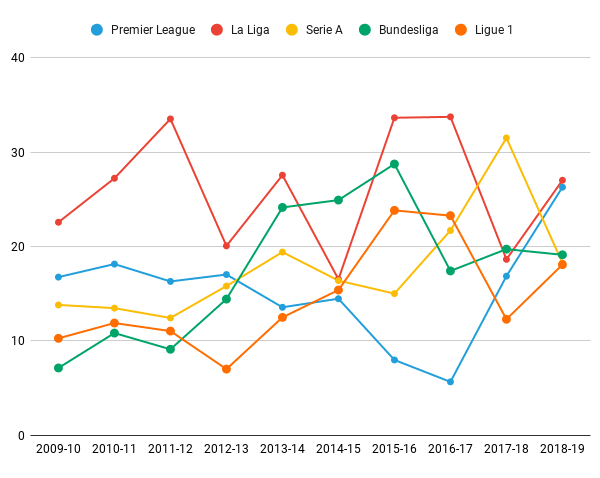
- We see a stark contrast between the odds of La Liga and the other leagues. It’s clear from this data that it’s almost impossible for weaker La Liga sides to beat the likes of Barcelona and Real Madrid at their respective homes. Especially the Catalans have imposed their supremacy at Nou Camp over the last decade.
- Premier League’s score has been impacted by two title-defenses in particular - Chelsea in 2015-16 and Leicester City in 2016-17. Both sides were poor during their respective title defenses and for obvious reasons, Jose Mourinho (Chelsea) and Claudio Ranieri (Leicester City) were sacked mid-campaign.
- However, Pep Guardiola’s Manchester City of 2018-19 were quite dominant and they registered similar numbers to Barcelona in La Liga.
- We witness that odds-average in Serie A significantly increased once Juventus pulled away from the rest of the league around 2013.
- Similarly in the Bundesliga, the league champions were less dominant in their title defenses from 2009 to 2013. However, since 2013, Bayern Munich have once again tightened their grip on the league.
- We see the same pattern with Paris Saint-Germain in Ligue 1. Around the turn of the decade, teams like Montepellier, Bordeaux and Lille failed to exert their dominance in their respective title defenses. However, since 2013, PSG started to dominate the league, and their odds-average displays a consistent improvement. The trend takes a dive in 2017-18 when Monaco were the defending champions.
- According to our data, over the period of the last ten years, it has been easiest for promoted sides to beat Ligue 1 champions at their home. However, this nod would go to Premier League champions if we consider only the last five years.
- These odds are not just defined by the prowess of defending champions. On rare occasions, some promoted sides turn out to be better than the normal standard. Wolves from the 2018-19 Premier League season and Monaco from the 2013-14 Ligue 1 season are such examples.
Top three vs bottom five
In this section, we further dissect the gap between the sides at both ends of various leagues. In order to do so, we looked at all the games played between the top-three and the bottom-five sides from the last ten seasons in all five leagues.
The following graph shows points picked up by the bottom five sides against the eventual champions and the top-three sides every season.
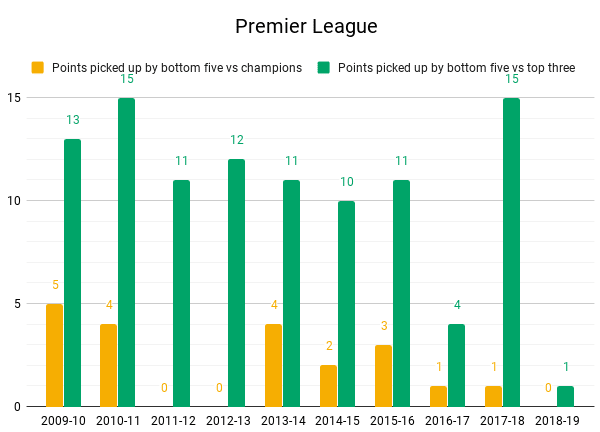
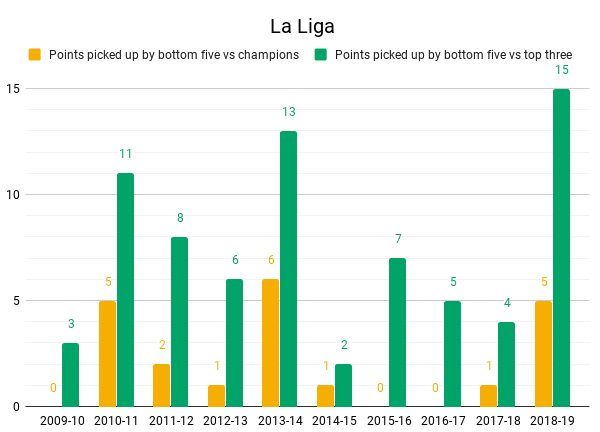
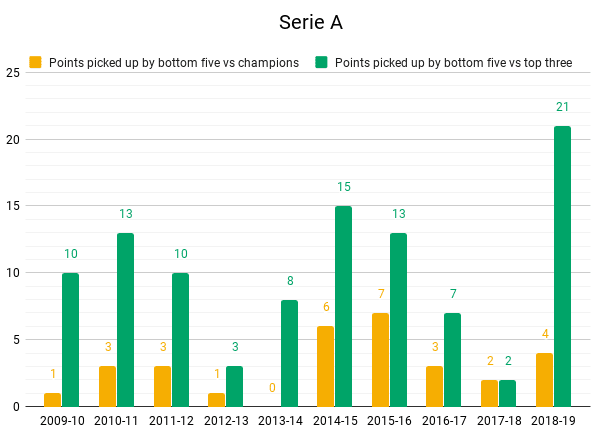
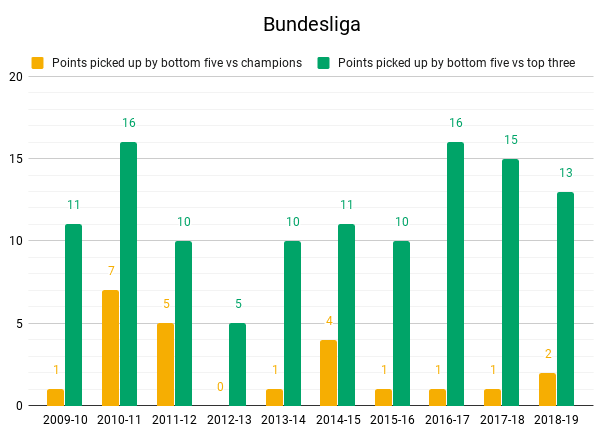
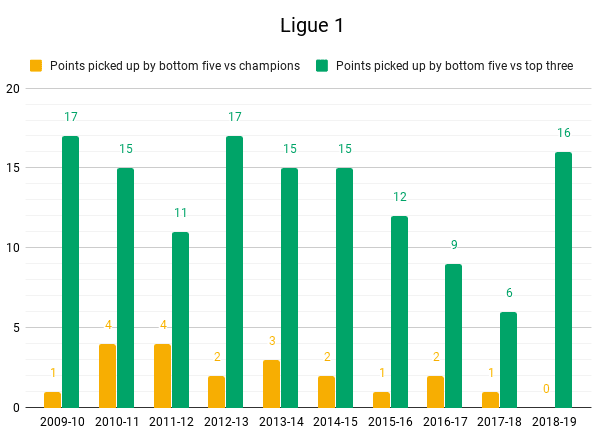
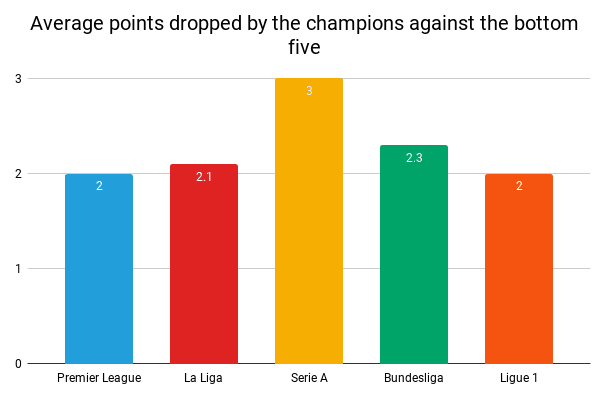
- Surprisingly, Juventus have a habit of dropping points against the lower sides in Serie A. Bottom five sides have picked up 6,7,3,2,4 points respectively in the last five seasons against the Italian giants.
- The average of points dropped by the champions in Bundesliga has shot up particularly because of Dortmund’s performances against the bottom-five during their title triumphs in 2010-11 and 2011-12.
- Bayern Munich have lost only once against the bottom-five in their eight Bundesliga title triumphs during the last decade.
- PSG have been quite efficient against the bottom five sides too as they have lost only once against them in their six title wins in the last seven seasons.
- In stark comparison, Juventus have lost five times against the bottom-five sides in the title-winning seasons during the past decade.
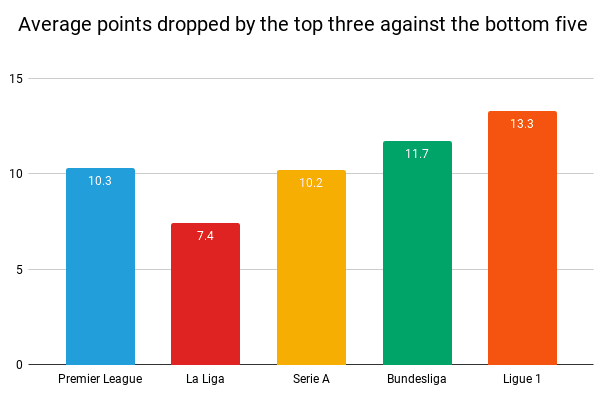
- La Liga matched with most other leagues in the previous graph, but the top-three in the Spanish league have performed significantly better than the top-three of other leagues, against the bottom-five. This signifies that the teams finishing in the second and third spot in La Liga perform much better than their peers in other leagues.
- Quite the reverse is true for Ligue 1 implying that the teams finishing in the second and third spots are relatively weaker against the bottom sides.
- Readers must note that the Bundesliga is an 18-team league, and their bottom five are sides ranked 14th-18th, rather than 16th-20th, as is the case in other leagues. Hence, the level of difficulty of facing the bottom five is slightly higher in the German top tier.
Conclusion: Premier League has been the most competitive league of the last decade
After looking at various conclusions from our multi-layered analysis, we can claim that the Premier League has scored the most points to be the most competitive top soccer league in Europe during the past decade.
The top tier of English football has not only produced some thrilling title races, but also, it has produced the second-highest number of champions. Furthermore, the top-five of the Premier League has been more congested than any other league, indicating the close competition at the top end.
However, at the same time, the competition for Champions League spots is quite predictable in this league as no side besides Leicester City has managed to break the supremacy of the big six during the last decade.
Meanwhile, La Liga has matched Premier League in terms of producing some nail-biting finishes to title races over the last decade. However, the top tier of Spanish football is less prone to top sides dropping points against the bottom-five, and it also has the biggest average-gap between the first and the fifth side in the table.
Ligue 1, Bundesliga, and Serie A have mostly been dominated by a single side in recent years, and they haven’t provided much entertainment when it comes to title races. However, there is a bigger variety in the top-four of these leagues when compared to Premier League.
About RunRepeat:
At RunRepeat, our main objective is delivering objective, unbiased shoe reviews. We buy all shoes and test them extensively. We even cut the shoes in half to test all the materials in the shoes and rate the performance of the shoe. This way, you know the exact 1-5 rating of the shoe for breathability, durability of the outsole, durability of the heel counter; we also test other features like softness, flexibility, torsional stiffness, etc. Read more about our in-house testing here.
If you like this piece, don’t forget to read our other articles on sports.
You are welcome to use any of the mentioned data in your own article. But, please do credit RunRepeat as the original source of any information. For any inquiries, reach out Vyom at vyom@runrepeat.com.
